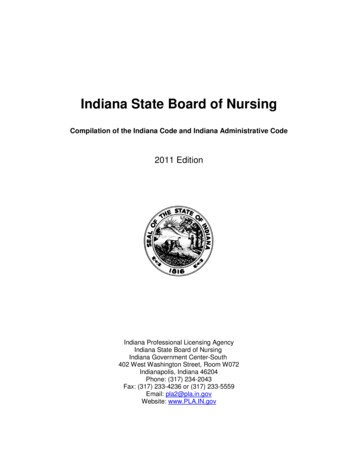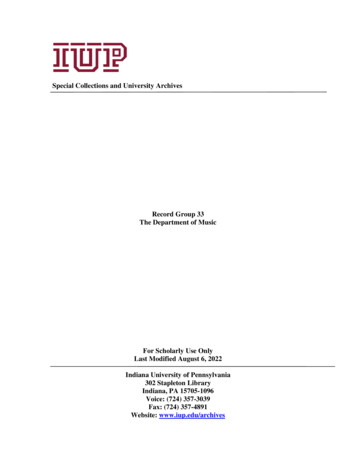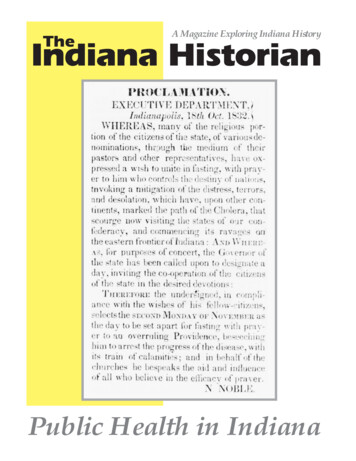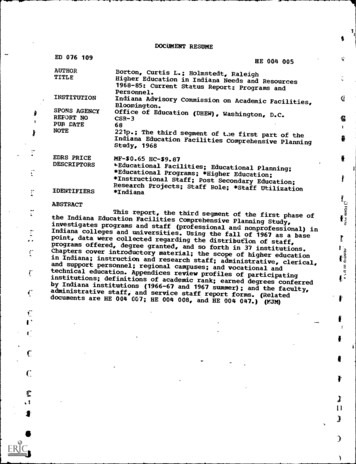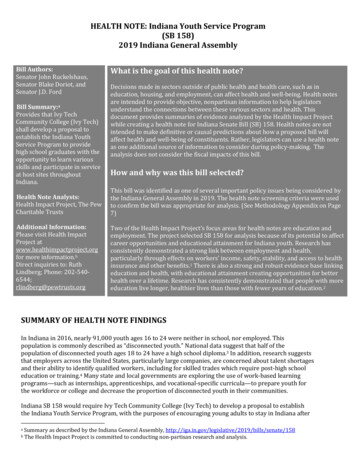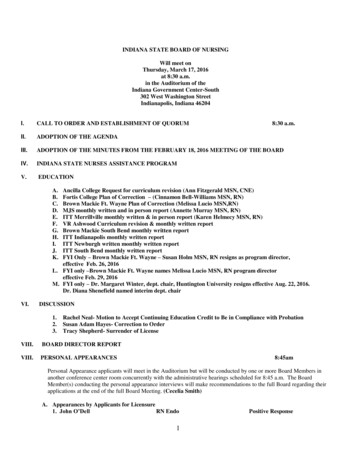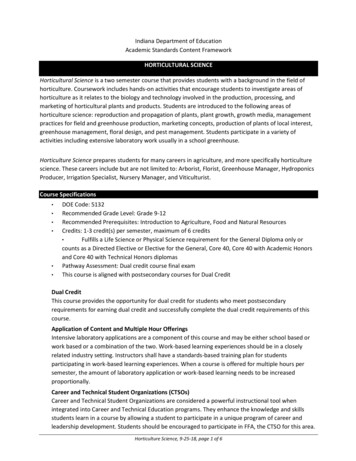
Transcription
Indiana Department of EducationAcademic Standards Content FrameworkHORTICULTURAL SCIENCEHorticultural Science is a two semester course that provides students with a background in the field ofhorticulture. Coursework includes hands-on activities that encourage students to investigate areas ofhorticulture as it relates to the biology and technology involved in the production, processing, andmarketing of horticultural plants and products. Students are introduced to the following areas ofhorticulture science: reproduction and propagation of plants, plant growth, growth media, managementpractices for field and greenhouse production, marketing concepts, production of plants of local interest,greenhouse management, floral design, and pest management. Students participate in a variety ofactivities including extensive laboratory work usually in a school greenhouse.Horticulture Science prepares students for many careers in agriculture, and more specifically horticulturescience. These careers include but are not limited to: Arborist, Florist, Greenhouse Manager, HydroponicsProducer, Irrigation Specialist, Nursery Manager, and Viticulturist.Course Specifications DOE Code: 5132Recommended Grade Level: Grade 9-12Recommended Prerequisites: Introduction to Agriculture, Food and Natural ResourcesCredits: 1-3 credit(s) per semester, maximum of 6 credits Fulfills a Life Science or Physical Science requirement for the General Diploma only orcounts as a Directed Elective or Elective for the General, Core 40, Core 40 with Academic Honorsand Core 40 with Technical Honors diplomasPathway Assessment: Dual credit course final examThis course is aligned with postsecondary courses for Dual CreditDual CreditThis course provides the opportunity for dual credit for students who meet postsecondaryrequirements for earning dual credit and successfully complete the dual credit requirements of thiscourse.Application of Content and Multiple Hour OfferingsIntensive laboratory applications are a component of this course and may be either school based orwork based or a combination of the two. Work-based learning experiences should be in a closelyrelated industry setting. Instructors shall have a standards-based training plan for studentsparticipating in work-based learning experiences. When a course is offered for multiple hours persemester, the amount of laboratory application or work-based learning needs to be increasedproportionally.Career and Technical Student Organizations (CTSOs)Career and Technical Student Organizations are considered a powerful instructional tool whenintegrated into Career and Technical Education programs. They enhance the knowledge and skillsstudents learn in a course by allowing a student to participate in a unique program of career andleadership development. Students should be encouraged to participate in FFA, the CTSO for this area.Horticulture Science, 9-25-18, page 1 of 6
Content StandardsDomain - Plant Classification, Anatomy, and PhysiologyCore Standard 1 Students apply knowledge of plant classification, plant anatomy and plant physiology tothe production and management of plants.StandardsHS-1.1Classify agricultural and ornamental plants according to taxonomy systemsHS-1.2Apply knowledge of plant anatomy and the functions of plant structures toactivities associated with plant systemsHS-1.3Apply knowledge of plant physiology and energy conversion to plant systemsHS-1.4Recognize nomenclature, anatomy, and plant physiology related to horticulturalplantsHS-1.5Differentiate between the major groups of horticultural plants: herbaceous andwoody, annual, biennial and perennial, temperate and tropicalHS-1.6Identify the common plant species used in horticultureHS-1.7Describe the basic functions of plants parts and how plants adapt to theenvironmentDomain - Environmental Factors, Nutrients and Growth MediaCore Standard 2 Students prepare and implement a plant management plan that addresses the influenceof environmental factors, nutrients and soil on plant growthStandardsHS-2.1Describe factors to be considered in selecting a greenhouse heating, cooling, andventilation systemHS-2.2Explain how heat, humidity, and gases affect greenhouse crops and photosynthesisHS-2.3Explain the importance of light intensity and duration and the effects on plant growthHS-2.4Compare and contrast an open and a closed environmental systemHS-2.5Describe the desired characteristics of an ideal growing mediumHS-2.6Evaluate different methods of watering plants and determine the appropriate methodfor individual plantsHS-2.7Explain the aspect of growth influenced by each of the essential elementsHS-2.8Describe the deficiency symptoms of the major plant nutrientsHS-2.9Explain the techniques of soil sampling and relate this process to testing the growingmedium and interpreting the results to recommend fertilizer applications and pHtreatmentHS-2.10Discuss the uses of chemicals to regulate plant growthHS-2.11Analyze soils and soil fertility related to horticultural plantsHorticulture Science, 9-25-18, page 2 of 6
HS-2.12Demonstrate knowledge of the environmental factors involved in ornamental plantproduction including soils, water, and pestsHS-2.13Characterize the types of environments involved in horticulture: greenhouse and indoorenvironmentsDomain - Management PracticesCore Standard 3 Students establish management practices for field, greenhouse productionStandardsHS-3.1Explain the differences between field production, nursery and greenhouse productionand the plants produced in eachHS-3.2Plan a project for growing and marketing horticultural cropsHS-3.3Identify parts of a greenhouse and describe interior layouts best suited for differentplantsHS-3.4Describe the differences in the levels of marketing and the marketing options availableto horticulture producersHS-3.5Address the challenges of packaging and shipping of horticultural productsHS-3.6Explain the benefits of wholesale and retail marketing for a particular productHS-3.7Describe the processes used to maintain plant quality during the marketing processHS-3.8Describe the structures, equipment, and material used in the production ofhorticultural cropsHS-3.9Design a strategy for implementing fruit or vegetable productionDomain - Production and Maintenance PracticesCore Standard 4 Students establish production and maintenance practices for field and greenhouseproduction.HS-4.1Generate a plan to water plants according to selected scheduled times andrequirementsHS-4.2Address the maintenance and overwintering storage of horticultural crops for variousclimatesHS-4.3Explain the procedures used to harvest and handle field grown horticultural cropsHS-4.4Compare accepted and new practices used in growing horticultural cropsHS-4.5Explain hydroponics and describe the specific challenges that must be overcome forsuccessful yieldsHS-4.6Address the purposes of pruning and tools needed as well as specific practices foreach major type of fruit and nut treeHS-4.7Recognize and explain plant design, installation, and maintenanceHS-4.8Describe and be able to reproduce the production of tree fruits, small fruits, flowers,and nursery plantsHorticulture Science, 9-25-18, page 3 of 6
Domain - Integrated Pest ManagementCore Standard 5 Students integrate an environmentally sound pest management system for healthy plantproduction.StandardsHS-5.1Discuss the common pests of horticultural plants and describe the damage inflicted tothe plantsHS-5.2Explain the different categories of plant diseases for flowers, vegetables, lawns, treesand shrubsHS-5.3Examine the methods used to control plant pests and identify the advantages anddisadvantages of eachHS-5.4Identify safe use of pesticides and proper first aid procedures for pesticide poisoningHS-5.5Discuss the physiological principles of herbicides and relate the action to aspects ofplant growthHS-5.6Explain the classification of herbicides and discuss the appropriate uses for each typeHS-5.7Interpret the impact of current state and federal regulations on pest control measures.HS-5.8Apply and adapt knowledge of integrated pest managementDomain - Plant PropagationCore Standard 6 Students apply methods of plant propagation for plant reproduction.StandardsHS-6.1Evaluate sexual and asexual reproduction and discuss the long term benefits andproblemsHS-6.2Demonstrate sowing techniques and provide favorable conditions for seedgerminationHS-6.3Describe the methods used to overcome seed dormancyHS-6.4Explain the methods of asexual propagation and identify which species and varietiesare best suited to each methodHS-6.5Describe the uses of synthetic rooting hormones and explain the varying need forsuch supplementationHS-6.6Develop a schedule for plant propagation to meet seasonal production demandsHS-6.7Describe the fundamentals of plant breeding and how it applies to ornamental plants.HS-6.8Conduct test associated with seed germination rates, viability and vigor.Domain - FloricultureCore Standard 7 Students learn, practice, and apply skills needed in the floriculture industry.Horticulture Science, 9-25-18, page 4 of 6
StandardsHS-7.1Evaluate design principles of a floral arrangementHS-7.2Identify and use tools and equipment specific to the floral industryHS-7.3Apply principles and elements of design that form the basis of artistic impression.HS-7.4Practice plant care for cut floral designs and other floral products.HS-7.5Evaluate methods of plant preservation techniques.HS-7.6Apply marketing strategies for floral productsDomain - CareersCore Standard 8 Students examine the scope of career opportunities in and the importance of agricultureto the economy.StandardsHS-8.1Evaluate the nature and scope of natural resources in agriculture, society, and theeconomyHS-8.2Describe career opportunities and means to achieve those opportunities in naturalresourcesHS-8.3Identify how key organizational structures and processes affect organizationalperformance and the quality of products and servicesHS-8.4Demonstrate those qualities, attributes and skills necessary to succeed in, or furtherprepare for, a chosen career while effectively contributing to societyDomain - LeadershipCore Standard 9 Students validate the necessity of leadership skills development in conjunction withparticipation in The National FFA Organization (FFA) as a critical component to a well-rounded agriculturaleducationStandardsHS-9.1Communicate clearly, effectively, and with reason through speaking, writing, visuals, andactive listening in formal and informal settingsHS-9.2Recognize and explain the role of the FFA in the development of leadership, education,employability, communications and human relations skillsHS-9.3Examine roles within teams, work units, departments, organizations, interorganizational systems, and the larger environmentHS-9.4Acquire the skills necessary to positively influence othersHS-9.5Develop a skill set to enhance the positive evolution of the whole personHorticulture Science, 9-25-18, page 5 of 6
Domain - Supervised Agriculture ExperienceCore Standard 10 Students validate the necessity of a Supervised Agricultural Experience (SAE) program asa critical component to a well-rounded agricultural education.StandardsHS-10.1Explain the nature of and become familiar with those terms related to an SAEprogramHS-10.2Explore the numerous possibilities for an SAE program which a student mightdevelopHS-10.3Develop an individual SAE program and implement record keeping skillsHorticulture Science, 9-25-18, page 6 of 6
These careers include but are not limited to: Arborist, Florist, Greenhouse Manager, Hydroponics Producer, Irrigation Specialist, Nursery Manager, and Viticulturist. . HS-7.3 Apply principles and elements of design that form the basis of artistic impression. HS-7.4 Practice plant care for cut floral designs and other floral products.
